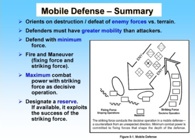Tactics 101: 029 – The Defense

Mobile Defense – A mobile defense is force oriented and has as its’ objective the ultimate defeat or destruction of the enemy. Within a mobile defense, there is normally a smaller portion of the force utilized to fix the enemy; while a larger force (strike force) is maneuvered to hit the enemy in the flank while it is fixed. There are several factors that must be in place or established in order to set the conditions to execute a mobile defense. These include: 1) Terrain that not only assists in fixing the enemy force, but facilitates maneuver by the striking force. 2) The defender possessing greater mobility than the attacker. 3) The ability to deceive the attacker as to the time and location of the strike force counterattack.
{default}Retrograde – Unlike the legendary Monty Python “run-away” scenes, a retrograde operation is an organized maneuver away from an enemy. A retrograde operation is conducted for various reasons. They include: gaining time, preserving a unit (personnel and resources), placing your opponent in an unfavorable position, forcing your enemy to expend valuable resources, or simply to avoid further contact with your enemy. A retrograde is one of the most challenging operations to execute. Certainly, psychologically it is not good for morale to be breaking contact with your opponent. Additionally, the vast majority of units do not train on conducting a retrograde operation. A cursory look at history finds that the first time most units plan and prepare a retrograde is when they must actually conduct one in combat. Retrograde operations include delays, withdrawals, and retirements. Again, a large unit may have smaller elements conducting each form. Why would a unit conduct a retrograde? Here are some potential reasons and they type of retrograde operation you may execute:
- Disengage from operations (Withdrawal/Retirement)
- Gain time w/o fighting a decisive engagement (Delay)
- Resist, exhaust, and damage enemy that do not favor a defense (Delay)
- Draw enemy into an unfavorable situation (Delay)
- Preserve forces or avoid combat that no longer promises success (Withdrawal)
- Reposition forces to favorable position (Withdrawal/Retirement)
- Position forces elsewhere to be used in other missions (Withdrawal/Retirement)
- Simplify logistic sustainment by shortening LOCs (Withdrawal/Retirement)
- Position forces where it can safely conduct reconstitution (Withdrawal/Retirement)
- Adjust defensive scheme (Withdrawal/Retirement/Delay)
- Deceive the enemy (Withdrawal/Retirement/Delay)
Let’s look at each form in a little more detail. (We will discuss in detail how to execute each of these in future articles).
[continued on next page]


